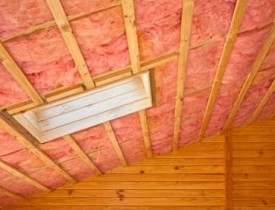Greener Fiberglass Insulation

Buying insulation is a lesson in the complexity of measuring sustainability. Insulation is designed to conserve energy, so all insulation companies can claim to be green -- and most do. But materials, production-cycle energy and toxicity are all other factors to consider. Considering all that, how green is traditional fiberglass insulation, and is it getting greener?
Energy Savings
Fiberglass batts are in the walls and ceilings of 90 percent of U.S. homes. They are cheap and efficient, providing the greatest energy savings per dollar spent on insulation. 12 inches of fiberglass batts offer a thermal resistance to R-39, the recommended minimum for ceilings in most of the country, and cost about 60 cents per square foot.
Loose-fill fiberglass insulation is less dense but also effective. Loose-fill cellulose insulation, a popular new alternative, is more dense than either type of fiberglass. However, it is also more expensive and will settle, losing insulation value over time.
Either type of loose-fill insulation can sneak into every gap and crack, where batts might come loose or fit poorly around wiring and light fixtures. Batts are easy to install but hard to install well. Loose batts and flimsy installation will dramatically reduce insulation values.
Components
Most new insulation products can't beat fiberglass on value, so they publicize their recycled materials and low-energy manufacturing. Fiberglass is starting to catch up on materials. The industry average is now 30 percent recycled glass fibers -- an improvement, to be sure, but far below the 80-percent recycled newspaper content in some brands of cellulose insulation.
Energy Use for Production
Industry analysts estimate fiberglass insulation production requires 10 times more energy than cellulose insulation production. Glass and sand are heated and spun into thin strands, an energy-intensive process. Fiberglass companies defend the product by saying far more energy is saved over the life of the fiberglass than is consumed in production.
Toxicity
While adding recycled glass, fiberglass companies have also reduced the amounts of formaldehyde and other volatile organic compounds. Some batts and bags of insulation include cancer warnings based on research findings that have since been revised. In 1994, the National Toxicology Program listed fiberglass as a potential carcinogen. The International Agency for Research on Cancer reversed the decision in 2001 based on new research.
Fiberglass companies are also finding alternatives to formaldehyde and other chemicals, and submitting to independent testing. The Greenguard Environmental Institute approved several brands for safe use in schools and for general indoor air quality. Fiberglass insulation labels still warn against direct contact because the small fibers can irritate the skin, eyes and throat. According to the federal government, fiberglass is not an allergen and does not affect indoor air quality after installation.
The Bottom Line
With dozens of alternatives on the market, fiberglass insulation continues to be a top seller because it is cheap and easy to install. It's a good DIY value, and it cuts energy consumption. The environmental value is otherwise fuzzy. You shouldn't feel ashamed of your pink batts, but you won't get any green awards for them either.
Looking for a Pro? Call us (866) 441-6648

Average Costs
Related Experiences

Sliding Glass Patio Door Replacement Eliminates Rotten Wood

Emergency Gas Valve Repair Restored Our Heat When Winter Hit Hard



